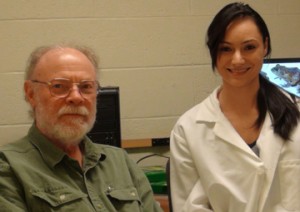By Dan Edelen
One of the foremost experts in bat echolocation, James Simmons ’65 knows about the invisible. He seeks to understand the nature of perception by studying the tiny mammal’s sounds pitched beyond the range of human hearing.

James Simmons '65 and Alyssa Wheeler '10, neuroscience graduate student, Brown University
“Most people interested in perception are interested in vision,” says Simmons, professor of biology, neuroscience department, Brown University.
Simmons took a different direction, though. By studying how bats convert invisible sound waves into a means of “seeing” their environment, he hopes to gain understanding into how humans navigate all of reality, not just the visual portions.
“Suppose you could reach into the brain and turn off some of the neurons responding to the visual stimulus and turn on neurons that were not responding. What would you perceive as a result?” Answering his own question, Simmons offers the scientist’s favorite basis for discovery: “We don’t know.”
Graduating with degrees in psychology and chemistry, Simmons worked with Burton Cohen, former professor of psychology, who researched hearing for the Navy at the Groton, Conn., submarine yard, and Howard Gallup, professor emeritus of psychology.
Cohen’s course on sensation and perception captured Simmons’ imagination. Like Cohen, Simmons uses his findings with bat echolocation to meet practical military needs. Understanding how bats process reflected sound in real time is used to improve sonar imaging and responsiveness.
Studying echolocation in bats was in its infancy when Simmons was earning his Ph.D. in psychology at Princeton. Since then, his significant contributions to the field have been acknowledged with the prestigious Silver Medal in Animal Bioacoustics from Acoustical Society of America. He has studied how bats use echolocation to map and remember flyways and how the nervous system influences animal behavior (systems neurobiology and neuroethology).
Simmons is an enthusiastic teacher as well.
Recalling the exuberance of professors Cohen and Gallup, Simmons’ pedagogical methodology sometimes includes, as he jokes, “waving my hands and yelling a lot,” adding, “it’s hard to teach science, but it is part of what you do. If a scientist is so concerned about his own personal career rather than teaching students, sooner or later that person’s contributions are going to disappear.”
That is why Simmons is a strong advocate for and participant in the Lafayette Alumni Research Network (LEARN) program, in which Lafayette students intern with alumni in the neuroscience field.
“We have hosted a LEARN student every summer for about a decade,” says Simmons. “And we are very happy to have such good students join us.” This summer Camille Borland ’13 assisted with neuroanatomical research on the auditory system of the big brown bat (Eptesicus fuscus). She worked with Alyssa Wheeler ’10, a former LEARN scholar and now a graduate student at Brown studying the gap junctions in the anterior ventral cochlear nucleus of the bat brain.
Last summer, Nick Navara ’13 and Simmons worked together to study how bats articulate perfectly timed, optimal sound frequencies for navigating through dense vegetation and for finding flying insect prey.
Regarding the benefits of LEARN, Simmons says, “If you want to be excited about science, you have to be excited by how it’s done.”
After a lifetime of research, Simmons concludes, “You try to find something, then you discover you found something different, and you try to make sense of what you found. It’s a self-surprising process.”
